Traditional Beijing Costumes
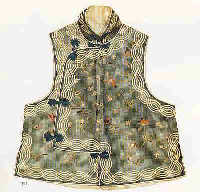
"Buddha needs to be decorated with gold, whereas human beings need to be decorated with clothes". "The four elements of life are clothing, food, residence and transportation, in which clothing comes first". These two old Chinese proverbs imply the significance of attire in Chinese culture. For Chinese, clothing is no longer just a necessity to keep warm. It represents a person's economical status and symbolizes an individual's role in the society. In the ancient capital of Beijing, costumes are (as they have been for a long time) more representative, reflecting the different societal custom and living habits throughout the different phases of Chinese history.
When the early Manchu rulers came to China proper (or the Central Plains) in the mid 17th century, they moved their capital to Beijing and set up the Qing Dynasty, which later unified China and the nationwide costume as well, with Chang Pao, cheongsams and Ma Gua replacing loose gowns and large sleeves of the former Ming Dynasty(1368-1644). And the Manchu empire forced the Hans to shave their heads and plaited their hair at the back, as the Manchu people did. Man had to wear Manchu style clothing but women could still wear Han style clothing.
The traditional costumes in Beijing are mainly legacies from the late Qing Dynasty (1644-1911) and the Republic of China(1911-1949), adopting both Han and Manchu styles.
Qing Style
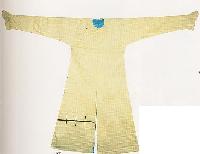
Chang Pao
Chang Pao was men's common wear, lower than the knees and with a round collar band. It was a long gown featured collarless, narrow horseshoe-shaped sleeves, buttons down the left front, four slits and a fitting waist. The slits could enhance men's freedom of mobility while they were riding the horse. Men wore thin Chang Pao made of cotton cloth in the summer, and warm cotton Chang Pao or fur-lined robe in the winter.
Chang Pao was originally the typical Manchu costume with horseshoe-shaped sleeves and slits on the four lower sides of the gown. Manchu came from the Northern region where its winter was much colder than Central China. These horseshoe sleeves were designed to cover the hands during winter times and men would curl the sleeves up during hunting or conducting their daily business. Therefore, during the early years of the Qing Dynasty , all male clothing had horseshoe-shaped sleeves. Like the Manchu, they would curl the sleeves up when they going about their daily business. When the imperial officers kowtowed to his superior officers or the emperor, the sleeves had to be to let down, covering the hands.
Meanwhile, the Manchus were known as people on the ride; hence their gown had four slits, with one on the left, right, front and back, which reached the knees. It was fitted to the body and rather warm. Fastened with a waistband, the long gown could hold solid food and utensils when people went out hunting.
With the changing of lifestyle and the integration of Han and Manchu cultures, Chang Pao changed a little bit later on, as the horseshoe-shaped sleeves were given up, and the style of four slits changed into two slits or even none. But you could still find horseshoe-shaped sleeves and four-slit style on Qing official gowns and that of people of high status.
Men's long gowns were mostly blue, gray or green; and women's, white. Some women decorated their gowns with beautiful silk ribbon laces at the front, the neckline and sleeve margins.
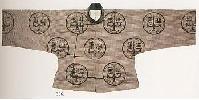
Ma Gua
Ma Gua was an outdoor jacket to keep warm. It was designed to have a short, baggy sleeves and above waist to enhance the mobility of horseback riding. It was initially used for the soldiers; therefore, it was also called Victory Gua. For a period, it was very fashionable among the wealthy to wear Ma Gua inside out showing the leather and fur.
Men wore thin Ma Gua made of cotton cloth in the summer, and warm cotton Chang Pao or fur-lined robe in the winter. Ma Gua with many different styles were mostly blue, purple, gray, or yellow; but men were not permitted to wear yellow Ma Gua unless it was awarded to them, since yellow is the imperial color.
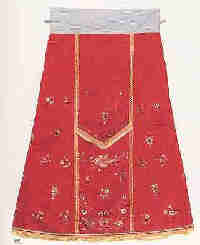
Dress adornments
Besides the Chang Pao and Ma Gua, other dress adornments Beijingers wore were the manteau, cloak, Ao (jacket), Kan Jian (waistcoat), Dun Zi (vest), Du Dou (bellyband), and Zhu Yao (waistband).
Ao was made of silks, satins or cotton cloth, wadded with silk floss or cotton. Women usually wore bright pink, cerise, and peach-blow jackets.
The manteau was in fact a surcoat with buttons down the front, large sleeves, and low collar, usually worn over the Ao (jacket).
The cloak, originating from coir raincoat in ancient times, was usually made of brightly colored silks and satins embroidered with varied designs. It was very common for women to wear a cloak during wintertime. Some even were decorated with precious furs of foxes and lynxes.
Kan Jian, a collarless and sleeveless waistcoat with buttons down the front, was very popular among the old and young, and male and female. An exquisite Kan Jian over the Ao would make the woman more elegant and refined. Today, it usually refers to the third piece of a three-piece male business suit, to distinguish it from other types of vests.
Dun Zi was a kind of underwear, collarless and sleeveless. Unlike Kan Jian, it was shorter and more close-fitting, with buttons down the oxter (armpit).
Du Dou, the bellyband, was the most mysterious and charming member in traditional Chinese costumes and popular among children and women in old Beijing. The bellyband was very formfitting and simple, usually with bright colors of red and yellow and embroidery patterns of flowers and birds, fresh peaches, and lovely moppets, full of Chinese ethnical feature and the sense of decoration. It was generally square in shape, with the above angle cut away to turn into two angles linked with a cloth or silk strip. The left and right angles each had a strip. The bellyband could nicely girdle the waist when hanged from the neck and tied at the back. The feminine Du Dou now has regained its spirit and life.
The waistband, about 0.3 meters wide, was usually favored by the elders. The thick band could keep the waist from cold by girdling it, with buttons down the right and the left sides.
During the Qing period, women wore two-piece clothing: one being the Ao (jacket), and one being the Qun (skirt), and sometimes pants.
The Manchu females had a custom of wearing Qixie (Manchu shoes) and males wearing boots. Officials wore square-toed boots, and commoners wore pointed-toed boots. Materials of the boots include satin, woven silks, cloth and leather, and so on. The Manchu shoes for women had a piece of flat wood as the tread, called "flat-tread shoes." Usually, there were colorized brims or bead string patterns on both the upper and the vamp.
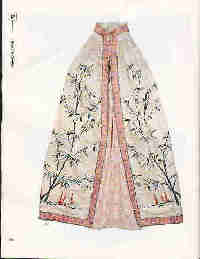
Related articles
-
 Poetical China: HanFu
Poetical China: HanFuMore
-
 How ancient Chinese clothes helped beat the summer heat
How ancient Chinese clothes helped beat the summer heatMore
-
 Palestinian Traditional Dress and Heritage Day
Palestinian Traditional Dress and Heritage DayMore
-
 Vietnamese traditional costume Ao Dai
Vietnamese traditional costume Ao DaiMore
-
 Activities held to celebrate Huazhao Festival in Hangzhou, E China
Activities held to celebrate Huazhao Festival in Hangzhou, E ChinaMore
-
 People celebrate Hua Zhao Jie in Fujian, SE China
People celebrate Hua Zhao Jie in Fujian, SE ChinaMore
